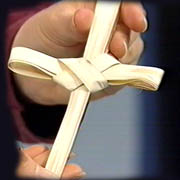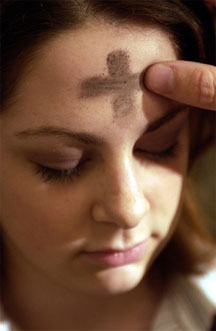Ash Wednesday
 From Conservapedia
From Conservapedia 
Ash Wednesday is the first day of Lent. Ash Wednesday derives its name from the practice of placing ashes on the foreheads of adherents as a sign of mourning and repentance to God. The ashes used are typically gathered after the palms or Palm Crosses from the previous year's Palm Sunday are burned.[1] This practice is common in most of Christendom, being celebrated by Catholics, Lutherans, Methodists, Presbyterians, and Anglicans.[2][3]
Either of the following phrases are said when ashes are placed on the participant's forehead:
- "Remember that you are dust, and to dust you will return."
- "Turn away from sin and be faithful to the gospel."

Contents
- 1 Origins
- 2 References
- 3 See also
- 4 External links
Origins[edit]
Ash Wednesday has been practiced since at least 1091, and there is evidence of similar rites as early as the sixth century AD.
References[edit]
- ↑ Ellsworth Kalas. Preaching the Calendar: Celebrating Holidays and Holy Days. Westminster John Knox Press. Retrieved on 8 March 2011. “We are wise, therefore to explain, whether in the course of the homily or in the church bulletin or newsletter, something of the meaning of the day: of ashes as an ancient symbol of loss and repentance; of the historic words spoken during the imposition of the ashes, "Remember that thou art dust, and to dust thou shalt return"; of the practice in many religious communions of using ashes made from the palms of the previous year's Palm Sunday; and, of course, that the imposition of ashes is a sign of mourning and repentance.”
- ↑ William P. Lazarus, Mark Sullivan. Comparative Religion For Dummies. For Dummies. Retrieved on 8 March 2011. “This is the day Lent begins. Christians go to church to pray and have a cross drawn in ashes on their foreheads. The ashes drawn on ancient tradition represent repentance before God. The holiday is part of Roman Catholic, Lutheran, Methodist, and Episcopalian liturgies, among others.”
- ↑ Sylvia A. Sweeney. An Ecofeminist Perspective on Ash Wednesday and Lent. Peter Lang. Retrieved on 8 March 2011. “In the twentieth century, the imposition of ashes became part of the liturgical experience of not only Roman Catholics, but Anglicans, Methodists, and Lutherans as well.”
See also[edit]
- Fat Tuesday
- Genesis 3:19
- Lent
External links[edit]
- American Catholic - History of Ash Wednesday
- History of Easter From the History Channel.
Categories: [Observances]
↧ Download as ZWI file | Last modified: 02/19/2023 14:02:53 | 24 views
☰ Source: https://www.conservapedia.com/Ash_Wednesday | License: CC BY-SA 3.0
 ZWI signed:
ZWI signed: KSF
KSF